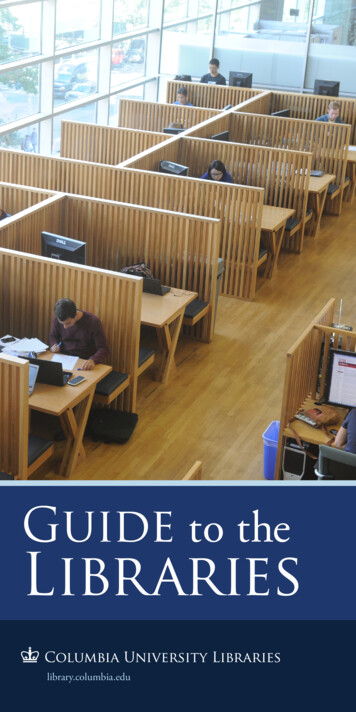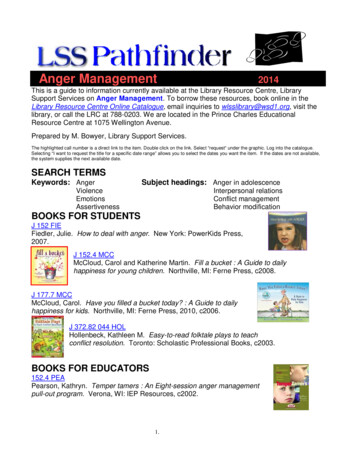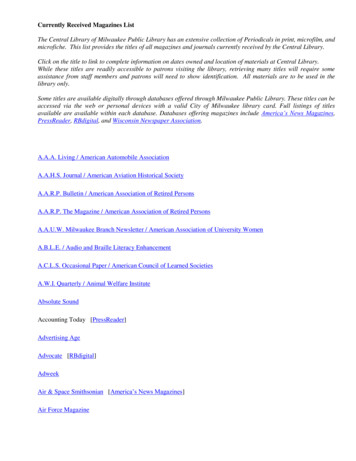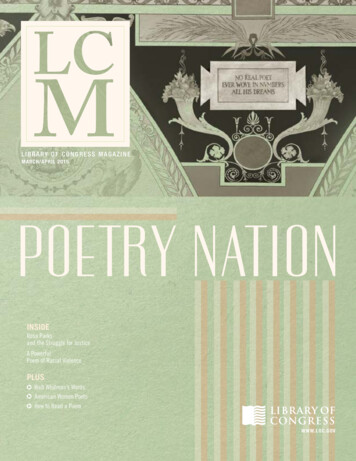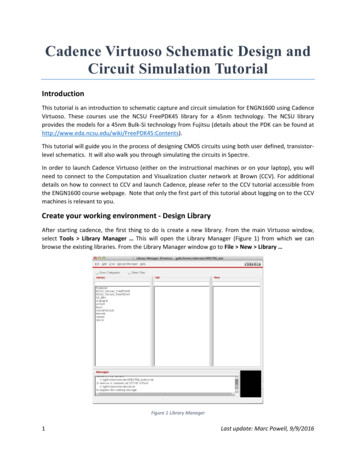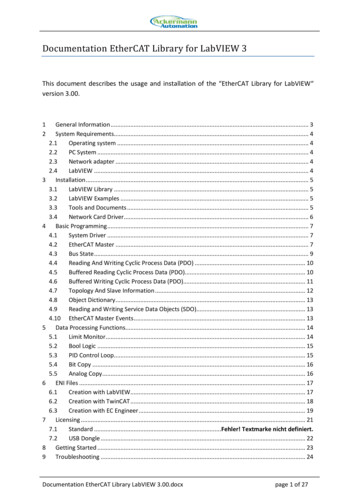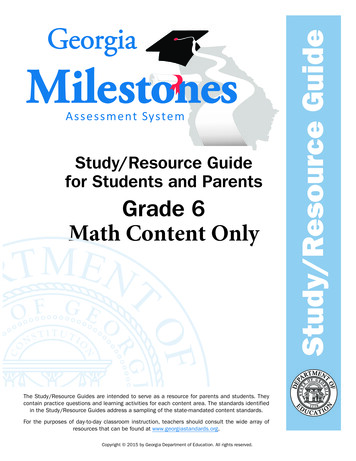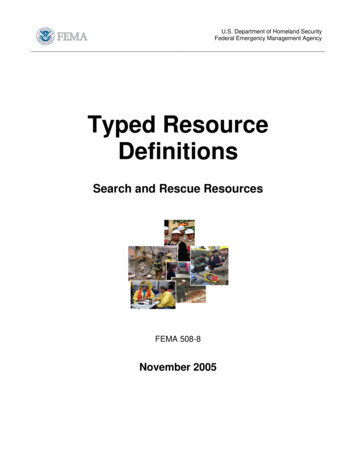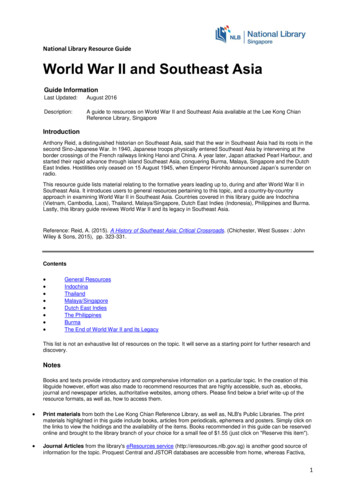
Transcription
National Library Resource GuideWorld War II and Southeast AsiaGuide InformationLast Updated:August 2016Description:A guide to resources on World War II and Southeast Asia available at the Lee Kong ChianReference Library, SingaporeIntroductionAnthony Reid, a distinguished historian on Southeast Asia, said that the war in Southeast Asia had its roots in thesecond Sino-Japanese War. In 1940, Japanese troops physically entered Southeast Asia by intervening at theborder crossings of the French railways linking Hanoi and China. A year later, Japan attacked Pearl Harbour, andstarted their rapid advance through island Southeast Asia, conquering Burma, Malaya, Singapore and the DutchEast Indies. Hostilities only ceased on 15 August 1945, when Emperor Hirohito announced Japan’s surrender onradio.This resource guide lists material relating to the formative years leading up to, during and after World War II inSoutheast Asia. It introduces users to general resources pertaining to this topic, and a country-by-countryapproach in examining World War II in Southeast Asia. Countries covered in this library guide are Indochina(Vietnam, Cambodia, Laos), Thailand, Malaya/Singapore, Dutch East Indies (Indonesia), Philippines and Burma.Lastly, this library guide reviews World War II and its legacy in Southeast Asia.Reference: Reid, A. (2015). A History of Southeast Asia: Critical Crossroads. (Chichester, West Sussex : JohnWiley & Sons, 2015), pp. 323-331.Contents General ResourcesIndochinaThailandMalaya/SingaporeDutch East IndiesThe PhilippinesBurmaThe End of World War II and its LegacyThis list is not an exhaustive list of resources on the topic. It will serve as a starting point for further research anddiscovery.NotesBooks and texts provide introductory and comprehensive information on a particular topic. In the creation of thislibguide however, effort was also made to recommend resources that are highly accessible, such as, ebooks,journal and newspaper articles, authoritative websites, among others. Please find below a brief write-up of theresource formats, as well as, how to access them. Print materials from both the Lee Kong Chian Reference Library, as well as, NLB's Public Libraries. The printmaterials highlighted in this guide include books, articles from periodicals, ephemera and posters. Simply click onthe links to view the holdings and the availability of the items. Books recommended in this guide can be reservedonline and brought to the library branch of your choice for a small fee of 1.55 (just click on "Reserve this item"). Journal Articles from the library's eResources service (http://eresources.nlb.gov.sg) is another good source ofinformation for the topic. Proquest Central and JSTOR databases are accessible from home, whereas Factiva,1
National Library Resource GuideEbscohost Academic Premier are available from libraries. You have to be a Digital Library member before youcan access the databases. If you are not a member yet, you may register at the eResources page free of charge.Use these keywords to assist your search: election, Singapore, polls, general election. Boolean operators (AND,OR, NOT) also help to limit the results. Newspaper articles are available from the Factiva database and the NewspaperSG database. Factiva isavailable via our eResources service and articles within can be accessed in the same manner as that for journalarticles (described above). Newspapers from NewspaperSG can be accessed .aspx. Straits Times articles from 1831 - 1989 can be accessedfrom home (direct links to the articles are provided) while articles from 1989 - 2006 can only be accessed onsiteat the libraries. Audiovisual materials and microfilm from Lee Kong Chian Reference Library should be viewed at thepremises. For AV materials, users may select their AV materials from the open shelves at Level 11 and proceedto the Audiovisual room located at the same floor of the National Library building. Microfilm users may select theirmicrofilm either from the shelves or approach the counter staff for assistance on microfilm retrieval. Users needto fill up a form at the counter before proceeding to the microfilm room to view the microfilms. Viewing of AVmaterials and microfilm are free of charge.For more detailed information on accessing our print resources and electronic databases, please peruse thefollowing section on "Accessing the Resources".2
National Library Resource GuideAccessing the ResourcesHow to access the Print MaterialsIntroductionYou can search the library catalogue (for physical materials) in the library and from home(http://catalogue.nlb.gov.sg). The easy search function allows you to search/browse by author, title, keyword,subject and ISBN/ISSN whereas the advanced search allows you to narrow your searches to specific mediatypes or language holdings. In both instances, you will also be able to limit your search to search only specificlibraries by clicking on the "limit by branch" option.To search Lee Kong Chian Reference Library's HoldingsIf you wish to search for only materials available in the Lee Kong Chian Reference Library, please always click onthe "Limit by Branch" button at the bottom of the page, after you have keyed in your search term. This brings youto a new page whereby you will be able to select the library of your choice. Choose "Lee Kong Chian ReferenceLibrary" and select "yes" under the "Display only items available in the selected branch below" and then click onsearch.Things to note:Once you have identified the title that you need, please double check through the following information and writedown the necessary info:i. The "Status" of the item: the item is not available in the library, if the status displayed is "in transit", "inprocess" or "not ready for loan".ii. Double check that the item is in Lee Kong Chian Reference Library under "Branch".iii. Write down the Location Code and the Call Number of the item. This helps you to locate the item within LeeKong Chian Reference Library. Please refer to the table below for more information (Note: Please feel free toapproach the counter staff for help in locating the books.)All featured books and periodicals are located at the Lee Kong Chian Reference Library.LevelLocation Code11 - Singapore and SoutheastAsia (English) Collections10 - National Library GalleryRSING, RSEA, JRSING,YRSING, RAV, RCLOS*,RRARERDTYS, RDTSH, RDKSC*9 - Chinese, Malay and TamilResourcesRSING, RSEA, RCO, RART,RBUS8 - Arts & Social SciencesRART, RSING, RSEA, R,RDET7 - Government and BusinessInformation ServicesRSING-[AR], RBUS, RCR, RType of CollectionAll SING/SEA English materials except:Arts and Literature (which are on L8)Microfilms, Posters, Maps, AV collectionDonors’ CollectionsDonors’ GalleryExhibition GalleryAll Chinese, Malay and Tamil materials,except for China Business resources(RCR)All Arts collections including Singapore &Southeast Asia English literatureNon-SING/SEA Social Sciences collectionEdwin Thumboo CollectionBusiness, Science & TechnologycollectionsAnnual ReportsStandards* Point of access for collection is via L11.3
National Library Resource GuideHow to access the databasesTo begin using databases and other electronic resources, you will first need to register as a Digital Librarymember (registration is free-of-charge) at our eResources webpage (http://eresources.nlb.gov.sg/). Please notethe following conditions:i. Not all e-resources are accessible from home. Please refer to the access rights stated per resource on theeResources webpage.ii. If you are NOT a Singaporean/PR, you will not be able to access any of the e-resources from home (eventhose that are labelled as accessible from home on the webpage).iii. Please log in to the eResources portal to use the resources. Materials available in the library's eResources(e.g., articles in specific databases) may come up in your searches in Google, Yahoo, MSN, etc. However, youwill NOT be able to access those information if you are not logged in and searching from the eResources portal.When you face problems registering or logging in, please contact 6332 3255 or send an email tohelpdesk@nlb.gov.sg.If you wish to find information in the databases but am not sure where to begin, or needrecommendations on which databases to use, please use the "Ask A Librarian" function or send an emailto ref@library.nlb.gov.sg for help. The librarian will get back to you within three working days.4
National Library Resource GuideGeneral ResourcesBooks Kenʼichi Goto (2003). Tensions of empire: Japan and Southeast Asia in the colonial and postcolonial world.Singapore : Singapore University Press, National University of Singapore ; Athens, Ohio : Ohio University Press.Call Number: RSING 327.5205980904 GOTThis book starts with the closing decade of European colonial rule in Southeast Asia and discusses the wartimeJapanese empire and its post-war disintegration. Kratoska, P. (2002). Southeast Asian minorities in the wartime Japanese empire. London ; RoutledgeCurzon;New York, N.Y.Call Number: RSING 959.052 SOUThis book explores how the occupation affected various minority groups in Southeast Asia. Kratoska, P. (2001) South East Asia : colonial history [Volume IV: Imperial Decline, Nationalism and theJapanese Challenge (1920s – 1940s). London ; Routledge, New York : c2001.Call Number: RSING 959 SOUA collection of essays on Southeast Asia during the first half of the twentieth century —pre-war period and theJapanese Occupation Goodman, G. (1991). Japanese Cultural Policies in Southeast Asia during World War 2. London : Macmillan.Call Number: RSING 303.48252059 JAPThis book examines the cultural policies imposed by them during the first half of the 1940s, arguing that theJapanese failed to make an impact on the region’s culture. McCoy, A. (1980). Southeast Asia under Japanese Occupation. New Haven, CT (Box 13A, New Haven 06520) :Yale University Southeast Asia Studies.Call Number: RSING 940.5359 SOU -[WAR]The volume of essays argue that the Second World War constituted a “fundamental transformation in the region’spolitical history”. Mendi, W. (2001). Japan and Southeast Asia: International Relations. London; Routledge, New YorkCall Number: RSING 303.48252059 JAPThis volume explores Japan's relations with Southeast Asia since the Meiji era. Shores, C., & Cull B. (1992). Bloody Shambles. Volume 1, The drift to war to the fall of Singapore. London: GrubStreeCall Number: RSING 940.53 SHO -[WAR]Tells the story of the disastrous Allied air campaign across Singapore, Malaya, Burma, Ceylon and thePhilippines during WWII. Lebra, J. (1975). Japan's Greater East Asia Co-prosperity Sphere in World War II : selected readings anddocuments. Kuala Lumpur ; New York : Oxford University Press.Call Number: RSING 940.5352 LEB -[WAR]Contains thirty-three selected excerpts from scholarly, official and journalistic writings on Japan's approach to theoccupation of East and Southeast Asia during the war period.5
National Library Resource Guide Tarling, N. (2001). A sudden rampage : the Japanese occupation of Southeast Asia, 1941-1945. Singapore :Horizon Books.Call Number: RSING 940.5359 TARDescribes how the Japanese invaded Southeast Asia, the impact of the war, and the economics of the JapaneseOccupation. Banyai, R. (1974). Money and banking in China and Southeast Asia during the Japanese military occupation1937 – 1945. Taipei : Tai Wan Enterprises Co.Call Number: RSEA 332.10959 BANDescribes how the Japanese invaded Southeast Asia, the impact of the war, and the economics of the JapaneseOccupation Saburō, I. (1978). The Pacific War, 1931-1945: a critical perspective on Japan's role in World War II, translatedby Frank Baldwin. New York : Pantheon Books.Call Number: RCLOS 940.5352 IEN -[GH]This volume focuses on the sufferings of common people during the Second World War. Paine, S. C. M (2012). The wars for Asia, 1911-1949. New York: Cambridge University PressCall Number: R 355.00951 PAIAbstract: This book emphasizes the fears and ambitions of Japan, China, and Russia, and the pivotal decisionsthat set them on a collision course in the 1920s and 1930s. The resulting wars - the Chinese Civil War (19111949), the Second Sino-Japanese War (1931-1945), and World War II (1939-1945) - together yielded a viscerallyanti-Japanese and unified Communist China, the still-angry rising power of the early twenty-first century. Whilethese events are history in the West, they live on in Japan and especially China. Craigie, R. L. (1945). Behind the Japanese mask. London, Hutchinson & co., ltd. New York [etc.]Call Number: RUR R 952.033 CRAThis book “concerns the Farnham Castle Centre for International Briefing, widely acknowledged as the world'sleading provider of intercultural management training and briefing”. Silverstein, J. (1966). Southeast Asia in World War II. New Haven, Southeast Asia Studies, Yale University,Cellar Book Shop, Detroit, 1966.Call Number: RCLOS 959 SIL -[GH] Sbrega, J. (2015). The war against Japan, 1941-1945 : an annotated bibliography. London ; New York :RoutledgeCall Number: RSING 016.9405426 SBR -[LIB]This volume contains one of the most extensive annotated bibliographies on the USA’s fight against Japan in theSecond World War.Websites Asahi Shimbun in Englishhttp://www.asahi.com/ajw/The Asahi Shimbun’s website6
National Library Resource Guide West Point: World War Two, Asia WWII Asian Pacific Theater.aspxContains useful maps illustrating various battles in the Pacific Theatre of World War II. Japan’s Quest for Power and World War II in Asiahttp://afe.easia.columbia.edu/special/japan 1900 power.htmBriefly covers Japan’s economic policies, domestic politics, ideology and racism in the period leading up to andduring the Second World War, as well as the attack on Pearl Harbour. Campaign summaries of World War Two: Indian Ocean and Southeast Asia, including anOcean.htmA timeline on the major naval battles in the Pacific Theatre during the Second World War. University of Oxford: Financing Japan’s World War II Occupation of Southeast : This paper analyses how Japan financed its World War II occupation of Southeast Asia, the transfer ofresources to Japan, and the monetary and inflation consequences of Japanese policies. Japan’s apologies for World War rld/asia/japan-ww2-shinzo-abe.html? r 0Lists the apologies made by the Japanese government during war anniversaries.7
National Library Resource GuideIndochinaIndochina was important to Japan’s war efforts in both China and Southeast Asia. The Japanese governmentsought accord with the Vichy regime in France, which was pro-German. In July 1941, Japan secured military,naval and air facilities in southern Vietnam, using them as bases to attack various Southeast Asian countries. Bythe end of the year, Japanese warplanes based in the Saigon air-base started their bombing campaign againstSingapore. Two years later, the tide of the war turned in the favour of the Allies, and the Vichy Governor Generalof Indochina, Decoux started negotiations with the Charles De Gaulle and his forces of liberation in France. Inresponse, Japan took over the position of the Vichy French Indochinese government in March 1945, until itssurrender in August 1945.Reference: Tarling, N. (1966). A Concise History of Southeast Asia. (New York: F. A. Praeger), pp. 253-254.Books Rice-Maximin, E. (1986). Accommodation and resistance: the French Left, Indochina, and the Cold War, 1944 –1954. New York : Greenwood PressCall Number: RSEA 959.7041 RICThis book analyses the role of the French Left in the First Indochina War, and starts its narrative during theSecond World War. Le Manh Hung (2004). The Impact of World War II on the economy of Vietnam, 1939-45. Singapore: EasternUniversities Press, 2004.Call Number: RBUS 330.959703 LEThe author examines the “changes in economic policy and in the mechanism governing the economic life ofVietnam that enabled it to survive wartime conditions of blockade and isolation”. Gunn, G. C. (2014). Rice wars in colonial Vietnam: the Great Famine and the Viet Minh road to power. UnitedKingdom: Rowman & Littlefield.Call number: RSEA 959.704 GUNGunn covers the Great Vietnamese Famine in 1945. Raffin, A. (2008). Youth mobilization in Vichy Indochina and its legacies, 1940 to 1970. Lanham, Md. ; Plymouth :Lexington.Call number: RSEA 369.40959709044 RAFThis book explores the “causes and consequences of state-sponsored patriotic youth associations during WorldWar II in French Indochina”. Hammer, E. (1966). The struggle for Indochina, 1940-1955. Stanford, Calif., Stanford University Press [1966]Call number: RSEA 959.7 HAMThis book discusses major developments in Indochina, from the collapse of the Japanese empire to the 1954Geneva Conference.8
National Library Resource GuideJournal Articles The Kingdom of Kampuchea, March-October 1945: Japanese-Sponsored Independence in Cambodia in WorldWar IIAuthor: David P. ChandlerJournal: Journal of Southeast Asian Studies, Vol. 17, No. 1 (Mar., 1986), pp. 80-93Database: JSTORCovers the intervals of seven months in between French rule, in 1945. "First Catch Your Hare": Anglo-American Perspectives on Indochina during the Second World WarAuthor: John J. SbregaJournal: Journal of Southeast Asian Studies, Vol. 14, No. 1 (Mar., 1983), pp. 63-78Database: JSTORAbstract: This paper analyses Anglo-American wartime deliberations on Indochina, which largely revolved aroundthe postwar status of the French colony and France’s future role in the international security system. Japan through Vietnamese Eyes (1905-1945)Author: Tran My-VanJournal: Journal of Southeast Asian Studies, Vol. 30, No. 1 (Mar., 1999), pp. 126-146Database: JSTORAbstract: During two significant periods in Vietnamese history, 1905-1910 and 1940-45, Japan played aconsiderable part in shaping political and social developments within Vietnam. This study of the Vietnamesenationalist encounter with the Japanese examines the complex interaction between the two countries, anddescribes the impact of this relationship on Vietnam's efforts to achieve independence immediately after WorldWar Two. The Integration of Difference in French Indochina during World War II: Organizations and Ideology concerningYouthAuthor: Anne RaffinJournal: Journal of Southeast Asian Studies, Vol. 31, No. 3 (Jun., 2002), pp. 365-390Database: JSTORExplores the themes of citizenship and race in France and its colonies, through the case of Indochina duringWorld War II. Japanese Military Policy Towards French Indochina during the Second World War: The Road to the "MeigoSakusen" (9 March 1945)Author: Kiyoko Kurusu NitzJournal: Journal of Southeast Asian Studies, Vol. 14, No. 2 (Sep., 1983), pp. 328-353Database: JSTORAbstract: The Japanese occupied the Philippines in 1941, and Burma and Indonesia in 1942. French Indochina,then called Futsuin by the Japanese, continued to remain in French hands until 9 March 1945. It seemed topresent a contrasting picture vis-à-vis Japanese policies in other Asian countries and to contradict the declaredpolicy as expressed in the “Greater East Asia Co-Prosperity Sphere” (in Japanese Dai-Tōa-Kyoei-Ken). On 9March, however, this was reversed by the Japanese military action, which disarmed the French IndochineseArmy. This action has come to be known as the Meigo Sakusen (Meigo [bright moon] Action). Vietnamese, Chinese, and Overseas Chinese during the Chinese Occupation of Northern Indochina (1945-1946)Author: David G. MarrJournal: Chinese Southern Diaspora Studies, Vol. 4 (Sep., 1983), pp. 129-139Database: EBSCO Academic Search PremierAbstract: In late August 1945, after Japan's sudden collapse ended World War II, Chinese forces marched intonorthern Vietnam to take the Japanese surrender there. They would not leave again for more than a year.Drawing on extensive Vietnamese and French archival and newspaper research, this note discusses relationsbetween Chinese forces, local Vietnamese (including the new Vietnam government and its adherents), andChinese residents in northern Vietnam during this brief but trying interlude between the Second World War andthe First Indochina War9
National Library Resource Guide A Preliminary Inquiry into the Wartime Material Losses of Chinese in Vietnam, 1941-1947Author: Shiu WentangJournal: Chinese Southern Diaspora Studies, Vol. 4 (2010), pp. 117-128Database: EBSCO Academic Search PremierAbstract: This article investigates the damage inflicted on Chinese society in Vietnam by World War II (19411945) and the independence war that followed (1945-1954). It is based on information in the diplomatic archivesof the Republic of China held in the National Archives of Taiwan. During World War II, Chinese were not onlyimmigrants subject to French colonial law, but also Japanese economic hostages. The Japanese were also ableto profitably exploit the political division between the anti-Japanese government of Chiang Kai-Shek (蔣介石)inChungking and the pro-Japanese Nanking government of Wang Jing-Wei (汪精衛)to manipulate the Chinese inVietnam. In the First Indochinese War Chinese became targets of both antagonists, in the south especially. Thisarticle considers Chinese relations with the Vietnamese, Japanese, and French, and makes a preliminaryinventory of Chinese material losses in these two conflicts. A Mission of Vengeance: Vichy French in Indochina in World War IIAuthor: Mickelsen, Martin L.Journal: Air Power History, Vol. 55 No. 3 (2008), pp. 30-45Database: EBSCO Academic Search PremierAbstract: The article presents a profile of the Vietnam theater of World War II under the leadership of AdmiralJean Decoux of the Vichy French government and the incidents surrounding downed and captured Americanpilots. Details are given describing how Decoux used his policies to assist Axis Japan with military intelligenceand cooperation. The events surrounding the grounding and death of U.S. airman Melvin J. Norton are described,noting the strong reaction against it by many groups. Resultant actions by the French Underground in Vietnam toassist Allied forces and rescue prisoners of war are also profiled.Websites Ho Chi Minh and the ss.htmDetails the role of Ho Chi Minh and the role of the Office of Strategic Services in Indochina Vietnam independence ry/vietnam-independence-proclaimedIntroduces the context behind the proclamation of Vietnamese independence in 1945 Laos, World War II and the chaotic events after the sub5 3a/entry-2936.htmlProvides concise information on Laos’ involvement in World War Two Cambodia’s French colonial period, World War II and Struggle for Independence /Cambodia/sub5 2a/entry-2846.htmlProvides concise information on Cambodia’s involvement in World War Two Thailand’s War with Vichy hailands-war-vichy-franceAbstract: The story of an almost unknown war and its international repercussions on the eve of Pearl Harbor.10
National Library Resource GuideThailandIn December 1941, the Thai government agreed to allow passage of Japanese troops through its territory—theonly way of preserving its independence. With Japanese support, Thailand extended its territorial control toKengtung and Mongpan—both belonging to the Shan state in Burma—and four northern states of Malaya. Afterthe war, the Thai government sought peace with the British by returning the control of these territories to them,coupled with financial compensation in the form of rice deliveries.Reference: Tarling, N. (1966). A Concise History of Southeast Asia. (New York: F. A. Praeger), pp. 267-268.Books Kratoska, P. (2004). The Thailand-Burma railway, 1942-1946 : documents and selected writings. London :Routledge.Call Number: RSEA 940.5425 THA -[WAR]“This six-volume collection uses documents from archives in Australia, Great Britain, India, Malaysia, theNetherlands, the United States, Myanmar, Thailand and Japan to present a complete picture of the reality of the'death' railway”. Tamayama, K. (2005). Railwaymen in the war : tales by Japanese railway soldiers in Burma and Thailand, 194147. Houndmills, Basingstoke, Hampshire ; Palgrave Macmillan, New York, N.Y.Call Number: R 940.542591 RAI -[WAR]“The first book to bring to light the testimonies of (those) who worked with 55,200 British, Australian and Dutchprisoners of war in the construction of the 415 kilometre railway.” Reynolds, B. (2010). Thailand's secret war : the Free Thai, OSS, and SOE during World War II.Call Number: RSEA 940.53593 REY -[WAR]“Despite its 1941 alliance with Japan, Thai leaders managed to establish clandestine relations with China, Britainand the United States, each of which had ambitions for postwar influence in Bangkok. Based largely on recentlydeclassified intelligence records, this narrative history thoroughly explores these relations, details Allied secretoperations and sheds new light on the intense rivalry between the British Special Operations Executive (SOE)and the U.S. Office of Strategic Services (OSS).” Brailey, N. (2012). Masanobu Tsuji's 'underground escape' from Siam after the Japanese surrender. Leiden, TheNetherlands : Global OrientalCall Number: RSEA 940.54152092 TSU -[WAR].“Colonel Tsuji’s account of his escape into Thailand from the Japanese surrender in Bangkok in 1945, and thenfinding his way into China before returning to Japan in 1948”. Jayanama, D. (1978). Siam and World War II. Bangkok : Social Science Association of Thailand Press, 2521Call Number: RSEA 959.304 DIRThis book provides a first-hand account of Thailand's diplomatic, military, and economic history between 1938and 1948.Journal Articles "International Orphans": The Chinese in Thailand during World War IIAuthor: E. Bruce ReynoldsJournal: Journal of Southeast Asian Studies, Vol. 28, No. 2 (Sep., 1997), pp. 365-388Database: JSTORAbstract: An examination of Japanese efforts to gain the cooperation of the intrinsically hostile, but economicallyvital Overseas Chinese community in Thailand, this article also focuses on the impact of the Japanese wartime11
National Library Resource Guidepresence on the troubled relationship between the Chinese and the Thai authorities, and the success of Chineseentrepreneurs in turning adversity to advantage. The Commemorative Character of Thai Historiography: The 1942-43 Thai Military Campaign in the Shan StatesDepicted as a Story of National Salvation and the Restoration of Thai IndependenceAuthor: Eiji MurashimaJournal: Modern Asian Studies, Vol. 40, No. 4 (Oct., 2006), pp. 1053-1096Database: JSTORAbstract: This paper attempts to cast light on Thai historiography by comparing Thai, Japanese and Chinesedocuments regarding the Thai army’s advance into the Shan states. Thai-Japan Monetary Relations at the Start of the Pacific WarAuthor: William L. SwanJournal: Modern Asian Studies, Vol. 23, No. 2 (1989), pp. 313-347Database: JSTORAbstract: This paper discusses the Japanese monetary policy implemented in Southeast Asia, in particular how itwas carried out in Thailand during the first year of the war. A Flying Tiger' downed in northern Thailand returned to China with the help of the OSS and Free Thai partisansAuthor: Bob BerginJournal: World War II, Vol. 13, No. 5 (Jan.,1999), p. 26Database: EBSCO Academic Search PremierAbstract: Describes how William McGarry, an American fighter pilot during World War II in Thailand was helpedby the Free Thai, Thailand's anti-Japanese resistance movement. Aerial bombings campaigns of the troopswhere McGarry belong in Thailand against the Japanese air forces; Details on their campaigns; Background ofMcGarry. The Liquidation of World War II in ThailandAuthor: Herbert A. FineJournal: Pacific Historical Review, Vol. 34, No. 1 (1965), pp. 65-82Database: JSTORAbstract: This paper examines in detail the participation by the United States in the British-Thai negotiations.Websites Burma Railway: British POW breaks silence over lence-overhorrors.htmlOn the building of the Death Railway in Burma The Burma–Thailand ars/ww2/japan/burmathai/Australian POWs on the Death Railway Kanchanaburi War ry/2017100/KANCHANABURI%20WAR%20CEMETERYThe resting place of POWs who died building the Death Railway Thailand on/Search?cat id 17A listing of World War II sites in Thailand Thailand : Hellfire Pass Memorial Museum and Walking etails the construction of the Hellfire Pass Memorial Museum, and maps of the walking trail12
National Library Resource GuideMalaya/SingaporeIn December 1941, Japanese forces launched an invasion of Malaya, conquering it by the end of January 1942.On 15 February, the British surrendered Singapore to Japan. During the Occupation, the Japanese governmentadopted the divide-and-rule approach in managing the Chinese, Malay and Indian communities. It was a periodof uncertainty, as well as economic hardship for the Chinese. On the other hand, the Indian community perceiveditself to be at the forefront of efforts in liberating India.Reference: Tarling, N. (1966). A Concise History of Southeast Asia. (New York: F. A. Praeger), pp. 286-288.BooksWong, H. S. (2009). Wartime kitchen : food and
Yale University Southeast Asia Studies. Call Number: RSING 940.5359 SOU -[WAR] The volume of essays argue that the Second World War constituted a "fundamental transformation in the region's political history". Mendi, W. (2001). Japan and Southeast Asia: International Relations. London; Routledge, New York Call Number: RSING 303.48252059 JAP

